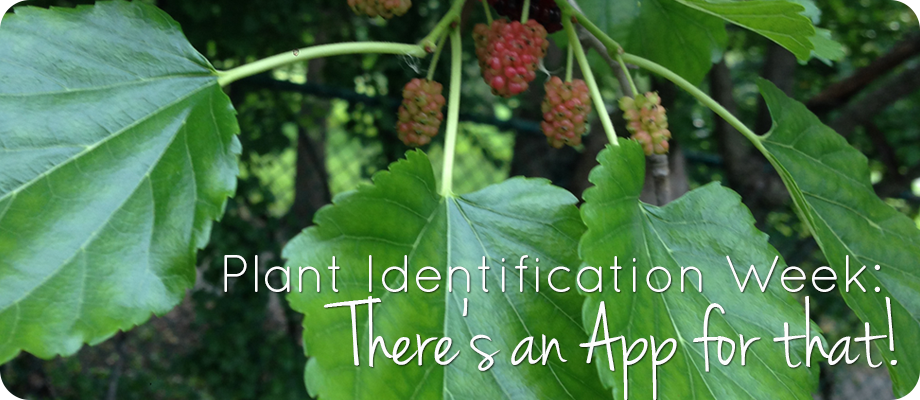
by Kristen | Jul 2, 2014 | plants
With Plantswoman’s office move I got to thinking about new homes and what to do about the gardens you inherit. Depending on what time of year you move it can be difficult to identify what is in your new garden or on your new property. So, I set out to see what I could find in terms of plant ID help. Our posts this week will be focused on plant ID resources starting today with free apps.
To start our discussion on apps let me just say there are tons of reviews out there for all sorts of plant ID apps (google tree ID apps or plant ID apps to review). So, instead of recreating the wheel I will simply let you know how they worked for me. The free apps I tried this round were Leafsnap, TreeID and Garden Compass. I chose these apps based on their reviews and general set up. Occasionally I suffer from technology ADD and using apps is when it comes out with a vengeance. I don’t like to spend a lot of time setting up apps and I want them to be pretty straight forward to use. I don’t typically read a lot of “how-to” articles before just diving in. When I started this project my intention was to download an app, grab my notebook and my little girl and head out to play tree detectives in our neighborhood. In spite of my enthusiasm I chose to download the apps and play with them first before dragging my daughter out into the neighborhood and I’m so very glad I did and I’ll tell you why as we go along.

First up is Leafsnap. Leafsnap is a pretty cool app that uses facial recognition software to identify plants. To ID a plant in question simply take a photo of it and let it search the database to find your answer. For the software to work however you do need to photograph your specimen on a white background. This is easily accomplished by using a notebook (which is what I did) or a piece of printer paper with out having to take the specimen off the plant. Some of the reviews I read complained of having to pick a leaf off the plant/tree which is destructive but with a little creative thinking I can’t really think of a reason you’d need to do that. So, what was my result? As cool as it is that Leafsnap has modified facial recognition software to ID plants it failed to ID every plant I tried. You may be wondering why (I certainly was)… It’s because Leafsnap is linked to the Smithsonian Institution’s catalog of trees and plants and that collection only covers the Northeastern United States. If you live in the northeastern United States you may have better luck with it than I but in the meantime we will need to wait as they work on expanding their catalog. They do have a pretty neat set of plant ID games but they tended to be a little buggy so I’d recommend waiting until they fix that as well.
 Next up is a free app called Tree ID and instead of using a recognition software it uses a database which is downloaded onto your phone/device. Once you open the app you answer some questions about your tree or plant and the app searches the database to find your answer. So I gave it a try. I diligently selected the leaf, leaf type, leaf arrangement, leaf size, leaflet size, number of leaflets (I didn’t really know what these were so I guessed to see what would happen), leaflet characteristics, leaf edge, leaf lobes (again, not quite sure), leaf edge teeth, leaf veins, leaf underside, leaf base, leaf stalk, leaf shape, leaf tip… And then you answer questions about the bark, autumn color, fruit and flowers. It took a long time to go through all that. I never knew there was so much that could be asked about leaves! And if that wasn’t enough I didn’t really know what half of the terms meant. There are little question mark symbols on each question that tell you what everything is but quite frankly I was a little overwhelmed by the detail. I tried to ID the lilac tree in our back yard by answering as many of the questions that I could and came up with no result. Then I tried again and reduced the number of questions I answered to give it a broader spectrum to choose from and still no result. By then I was just frustrated that technology had let me down that I went inside and did a little more research. There had to be something that was actually useful to a novice like me.
Next up is a free app called Tree ID and instead of using a recognition software it uses a database which is downloaded onto your phone/device. Once you open the app you answer some questions about your tree or plant and the app searches the database to find your answer. So I gave it a try. I diligently selected the leaf, leaf type, leaf arrangement, leaf size, leaflet size, number of leaflets (I didn’t really know what these were so I guessed to see what would happen), leaflet characteristics, leaf edge, leaf lobes (again, not quite sure), leaf edge teeth, leaf veins, leaf underside, leaf base, leaf stalk, leaf shape, leaf tip… And then you answer questions about the bark, autumn color, fruit and flowers. It took a long time to go through all that. I never knew there was so much that could be asked about leaves! And if that wasn’t enough I didn’t really know what half of the terms meant. There are little question mark symbols on each question that tell you what everything is but quite frankly I was a little overwhelmed by the detail. I tried to ID the lilac tree in our back yard by answering as many of the questions that I could and came up with no result. Then I tried again and reduced the number of questions I answered to give it a broader spectrum to choose from and still no result. By then I was just frustrated that technology had let me down that I went inside and did a little more research. There had to be something that was actually useful to a novice like me.
You may be picking up on the fact that this isn’t the most scientific research ever performed but this is how I roll. I’m sure I’m not the only one who is short on time. Like I said in the beginning I am looking for something easy to use, straight forward and helpful. I’m pleased to let you know I think I found something pretty special. Garden Compass…
When I was over at Gardenista looking at their review of ID apps (they had similar disappointing results by the way) I remember someone mentioning Garden Compass in the comments. I figure it couldn’t hurt so I took a look. Garden Compass is different from Leafsnap and Tree ID because it doesn’t rely on a database to ID your plant rather it relies on people. Yep, you read right, an actual person responds to you. Here’s how it works. Download the app to your phone or device and then you can take a photo or use a photo from your device that you’ve already taken. The app then emails the photo and the question to the Garden Compass Team. Once they’ve received your email you get a confirmation email and an idea of how long it should take them to get back to you. My emails both said “Our experts are doing their best to keep our response times to less than 24 hrs” and they aren’t kidding. I sent my question in at 3:51pm and had an answer back by 6:19am the next morning! Here is what I sent in…

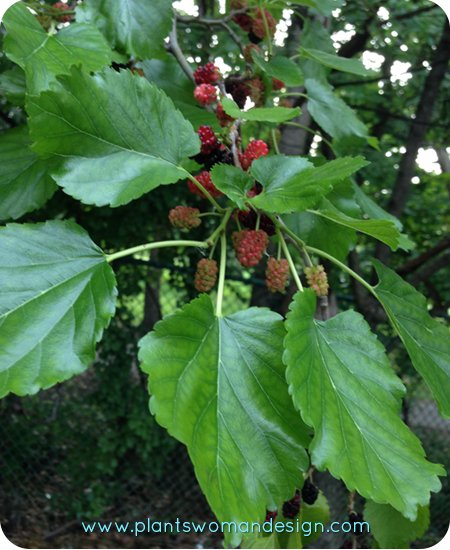 Here is what I got back…
Here is what I got back…
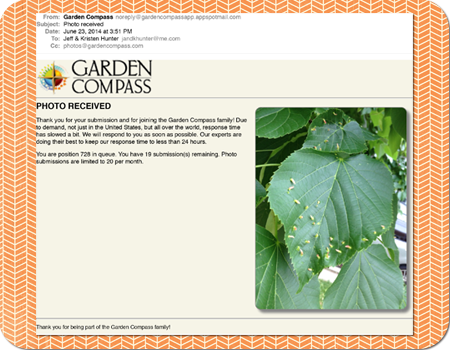
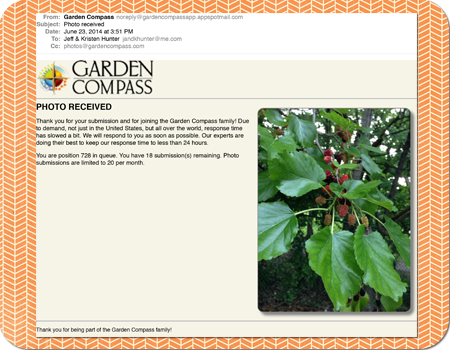 Did you notice how many were in queue before me? 728! The confirmation emails also keep tally of how many submissions I have left. You get 20 submissions per month.
Did you notice how many were in queue before me? 728! The confirmation emails also keep tally of how many submissions I have left. You get 20 submissions per month.
Pretty much the next day this was the response…
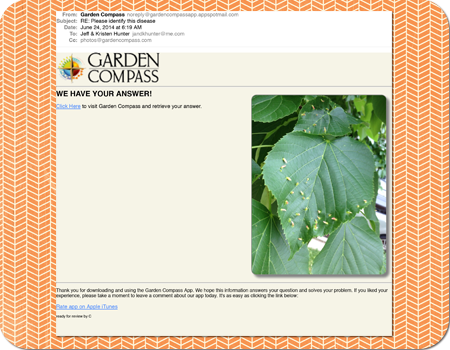 Click HERE to see all the answers they’ve sent me. I’ve sent in three submissions so far and all were correct with one slight exception. The identification of the tree with the leaf galls was given with a caveat that they couldn’t see enough of the tree to be sure so they made a guess.
Click HERE to see all the answers they’ve sent me. I’ve sent in three submissions so far and all were correct with one slight exception. The identification of the tree with the leaf galls was given with a caveat that they couldn’t see enough of the tree to be sure so they made a guess.
So, of the apps I tried, mind you I stayed with the free apps this round, Garden Compass is by far my favorite. They were quick and efficient and I really liked that I didn’t have to figure out how to finesse a database to give me what I wanted. And while there seems to be an app for just about everything my experience begs the question, is an app the appropriate way to go about this? Just because there are plant and tree ID apps out there perhaps the best way to go about this is the “old school” method. Come back on Friday as I head to my local library in search of an old school answer to an old school problem.
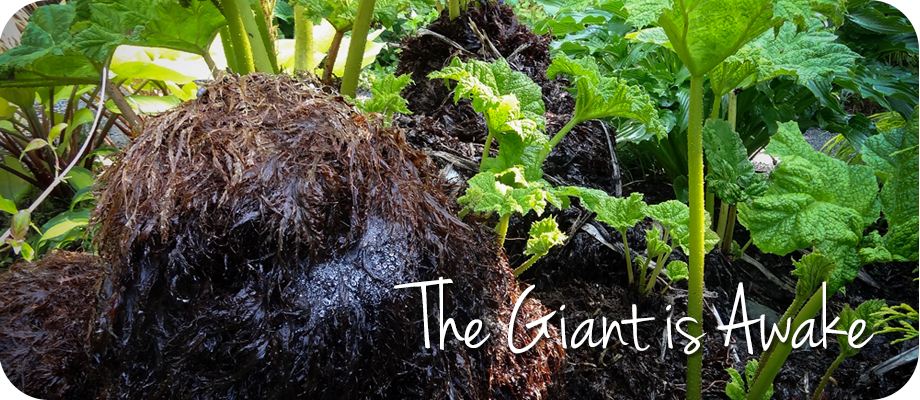
by Kristen | May 28, 2014 | plants, Plantswoman Design
Last week I had the opportunity to wander through Susan’s garden to grab some photos for our recent blog posts. As I walked along the pathways taking pictures I found myself drawn in by the detail of each different plant with their leaves still dripping with dew. I don’t know if this happens to you but I was so focused I stopped paying much attention to what was around me. Standing up after photographing a beautiful spirea ‘golden flame’ I spotted what looked like a dark, wet, dirty animal out of the corner of my eye and about jumped out of my skin. It wasn’t an animal though… It was Susan’s massive gunnera manicata and it was coming back to life.
We’ve posted photos of this gunnera before and even now in it’s new fresh from spring state it is enormous and lush. I hope you enjoy these photos that I took after my heart rate returned to normal and I could enjoy the greatness that is the gunnera manicata. And tell me if the massive rhizomes (clumping) at the base of the leaves doesn’t look like a giant coming up from the ground!

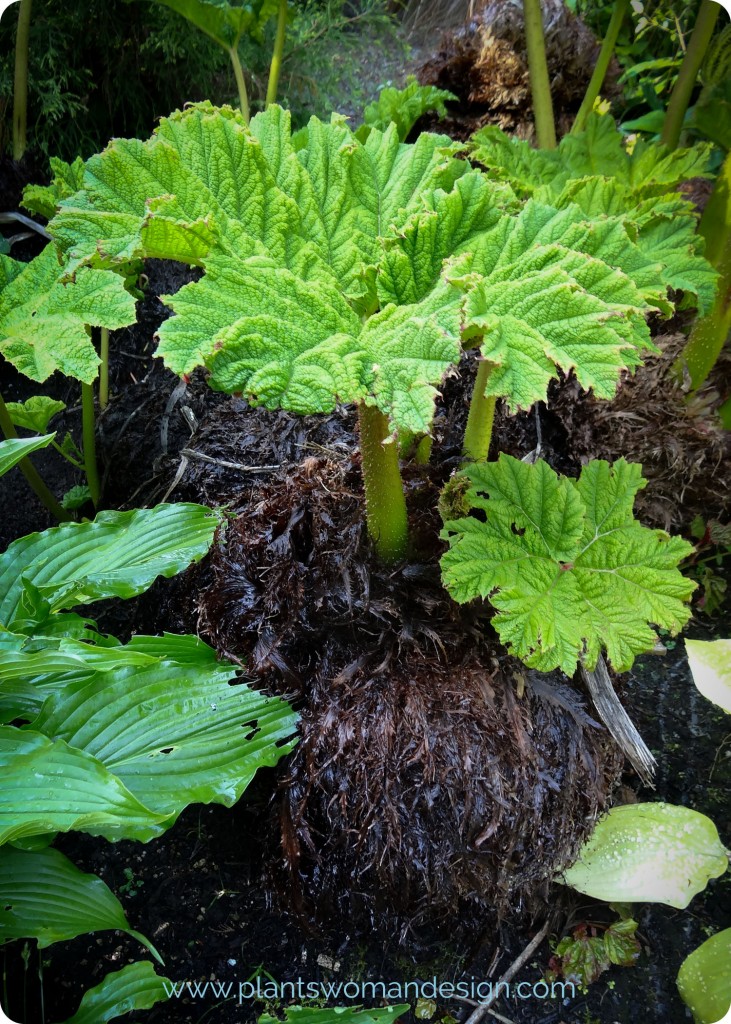

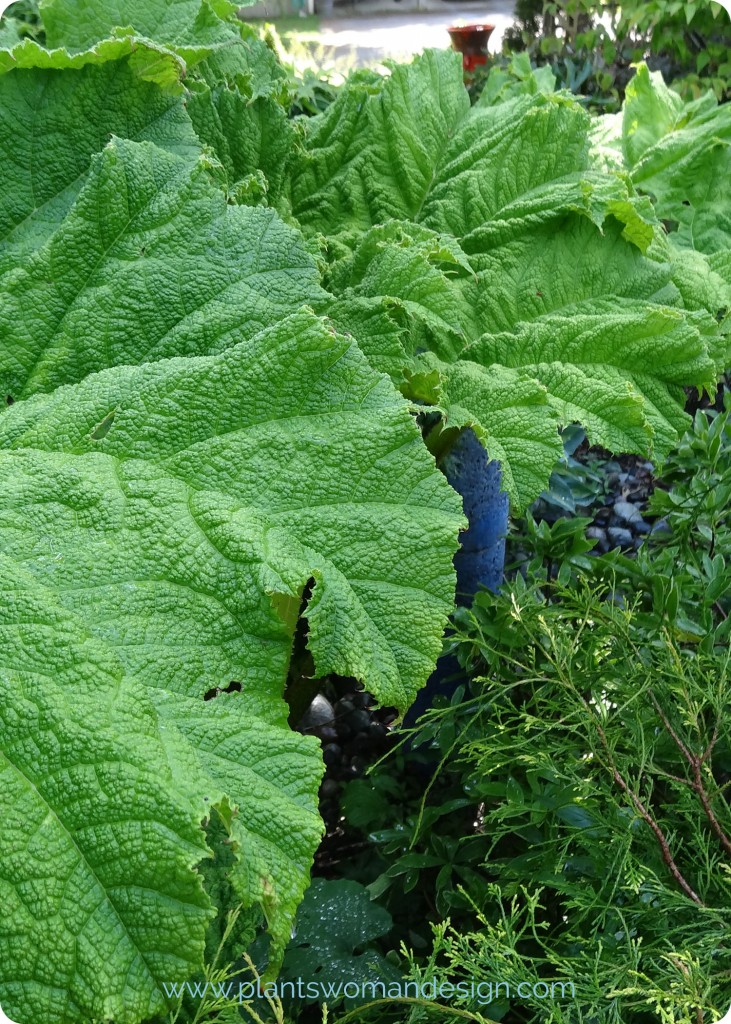
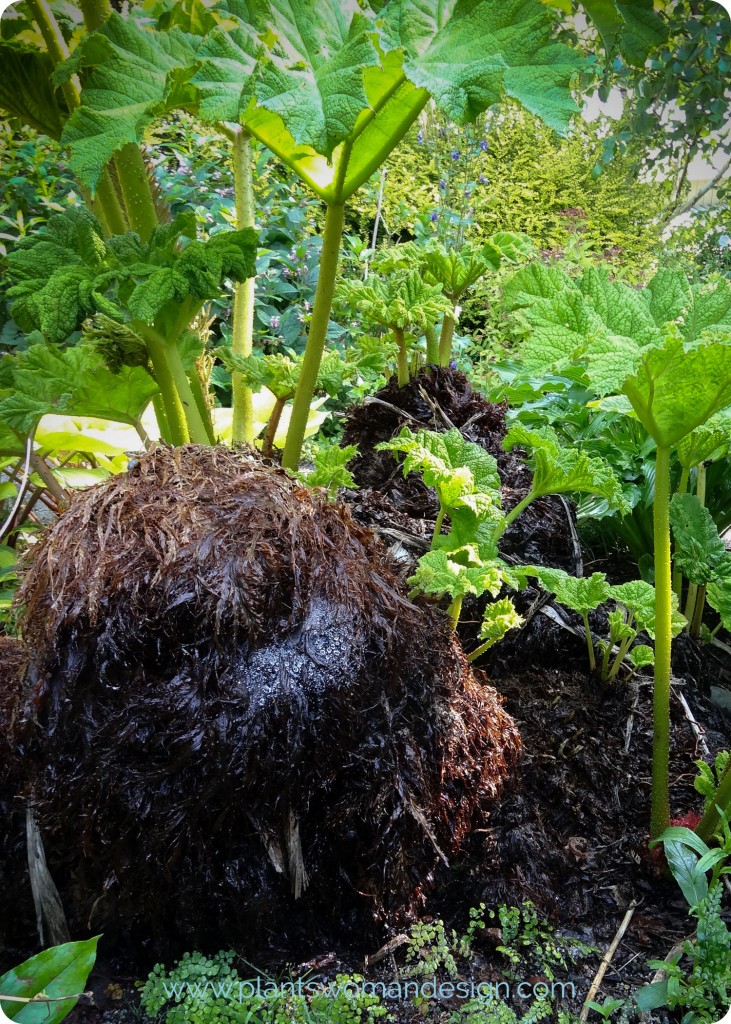
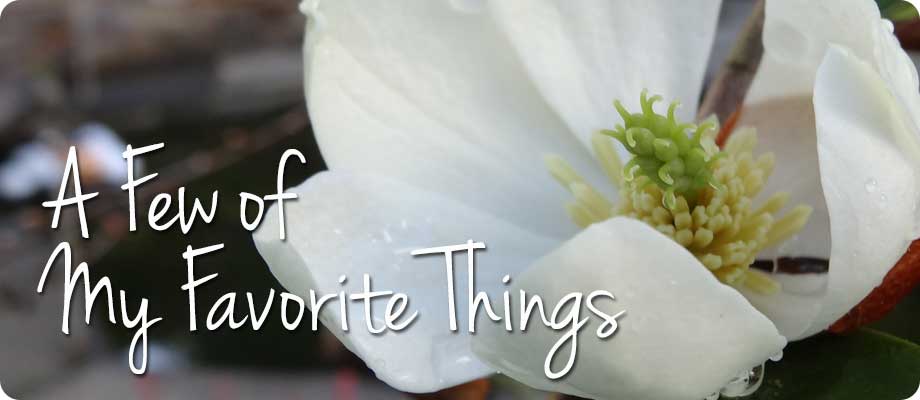
by Kristen | May 10, 2014 | gardening, plants
Of the many things I can list as one of my favorite things, rain is not one of them. As of today we have a 110% of our total rainfall for May, it is only the 5th. Lots of people just moan about it but the brave, raindrop-dodging gardener eagerly waits for a break in the rain to run out to see what is happening. We are all hoping that spring will be the rainy season and we will be rewarded with a long hot summer.
My plants are actually holding up well under the deluge. They are bravely showing their tender petals and fresh greens. Come with me as we take a quick tour of my garden and see what’s out there.
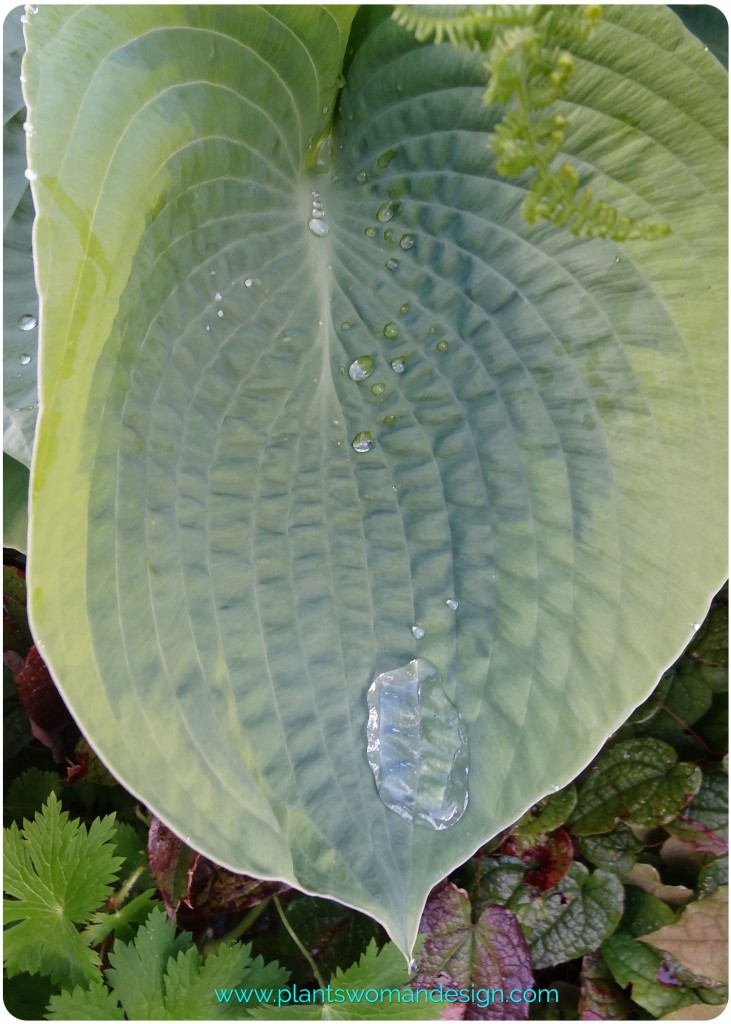
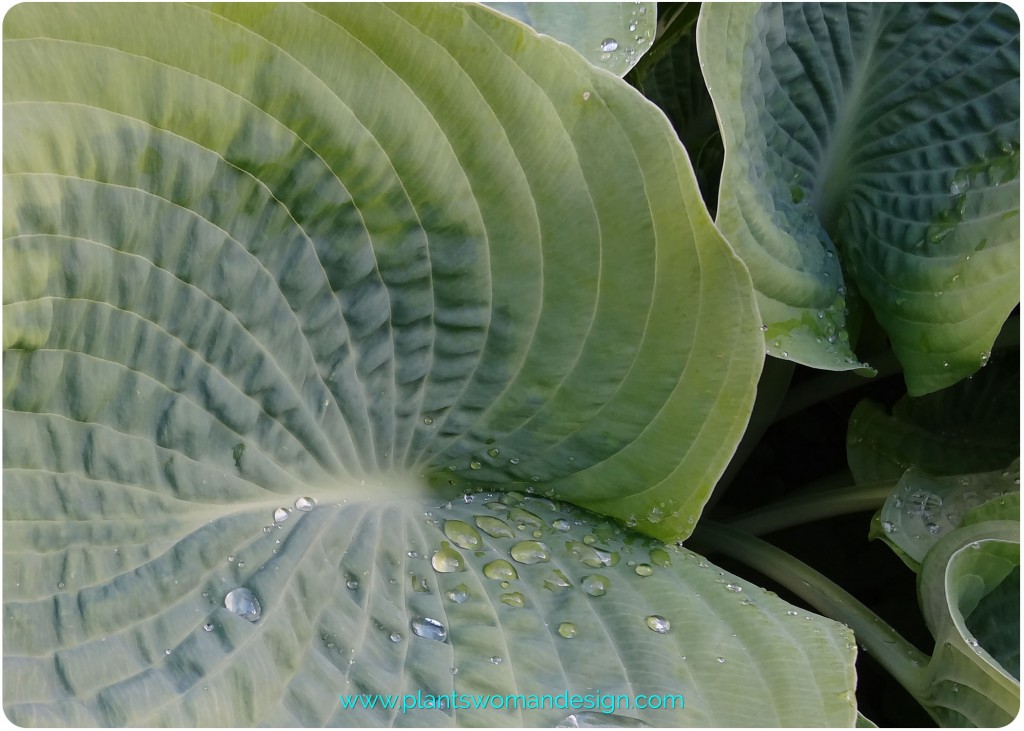
I am a big fan of color and texture. Flowers don’t always thrill me but sometimes they just demand my full attention. Then again blossom and texture can go together. This Magnolia Twanensis is fabulous this year with gigantic buds and plenty of them.
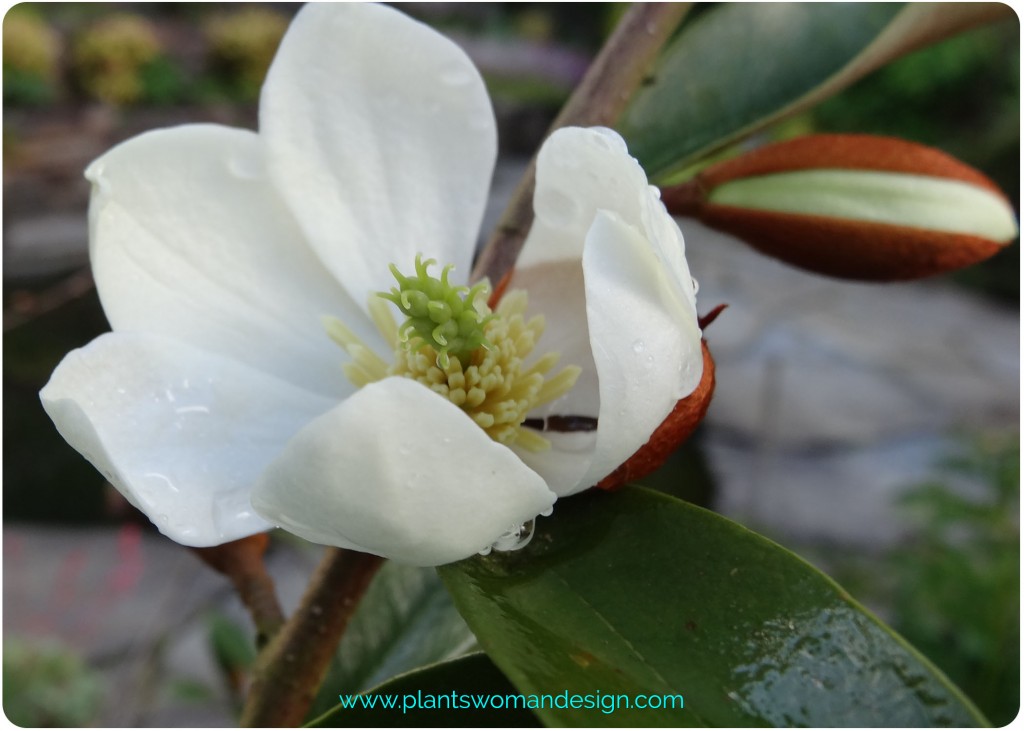
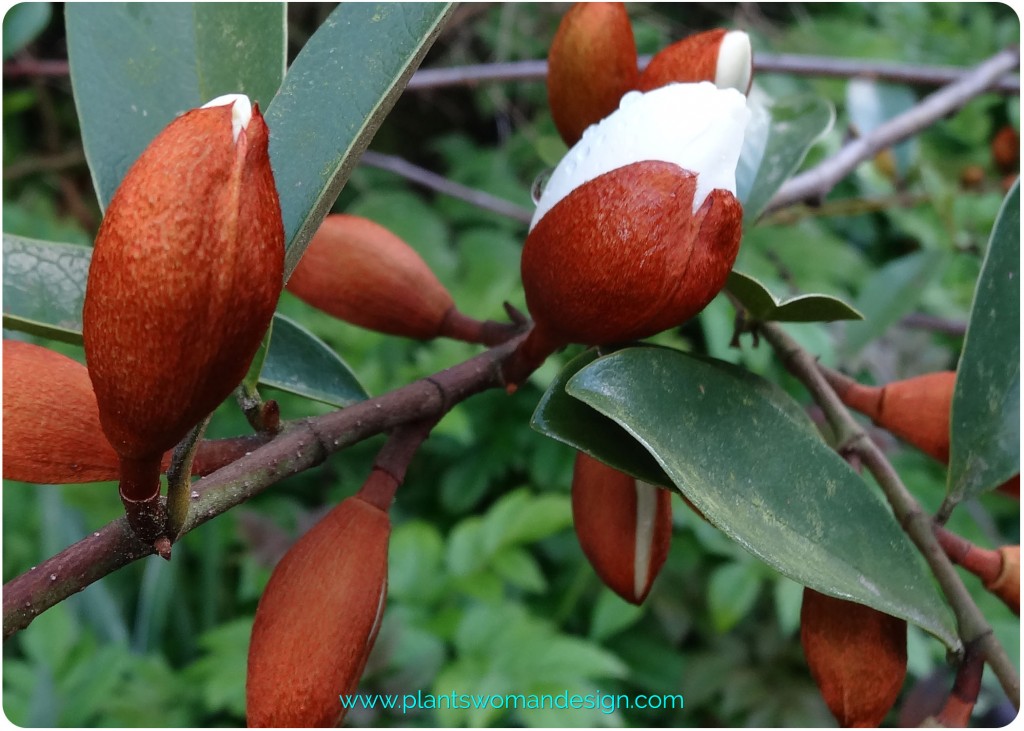
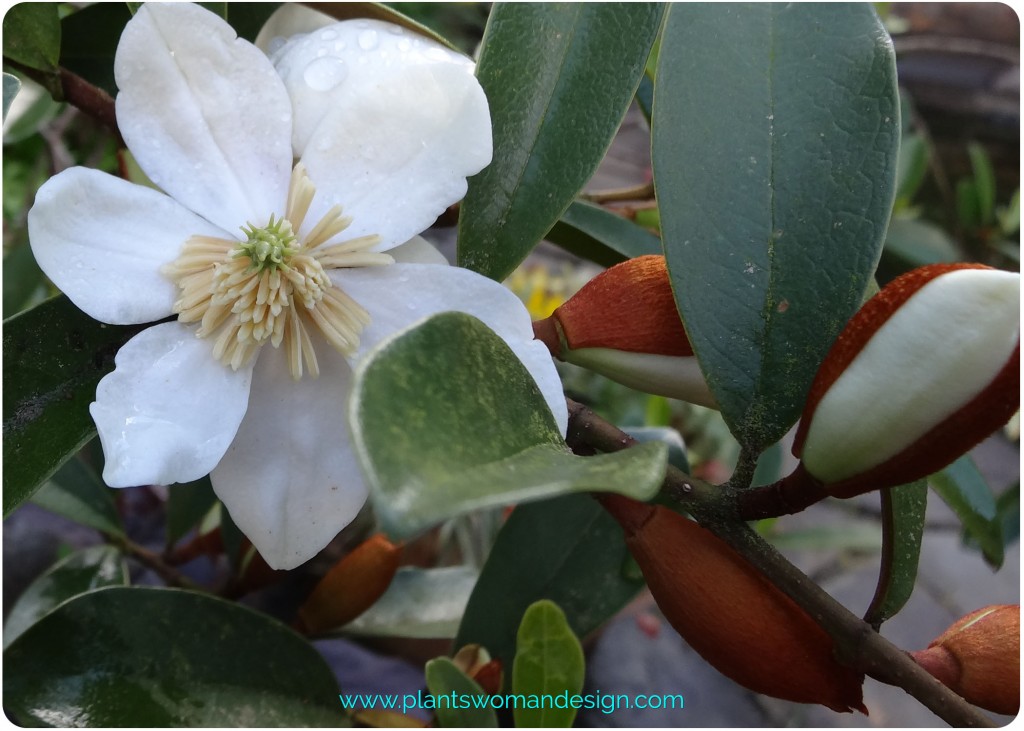
Peonies have light texture with delicate, tissue like petals. They are holding their heads up high and looking beautiful even through the rain. This is peony kinkaku is new to me this year.

This peony was rescued from a house that was being torn down. She needed a good home and I was happy to give her one. I usually get only 2-3 blooms on this tree and they are worth seeking out.
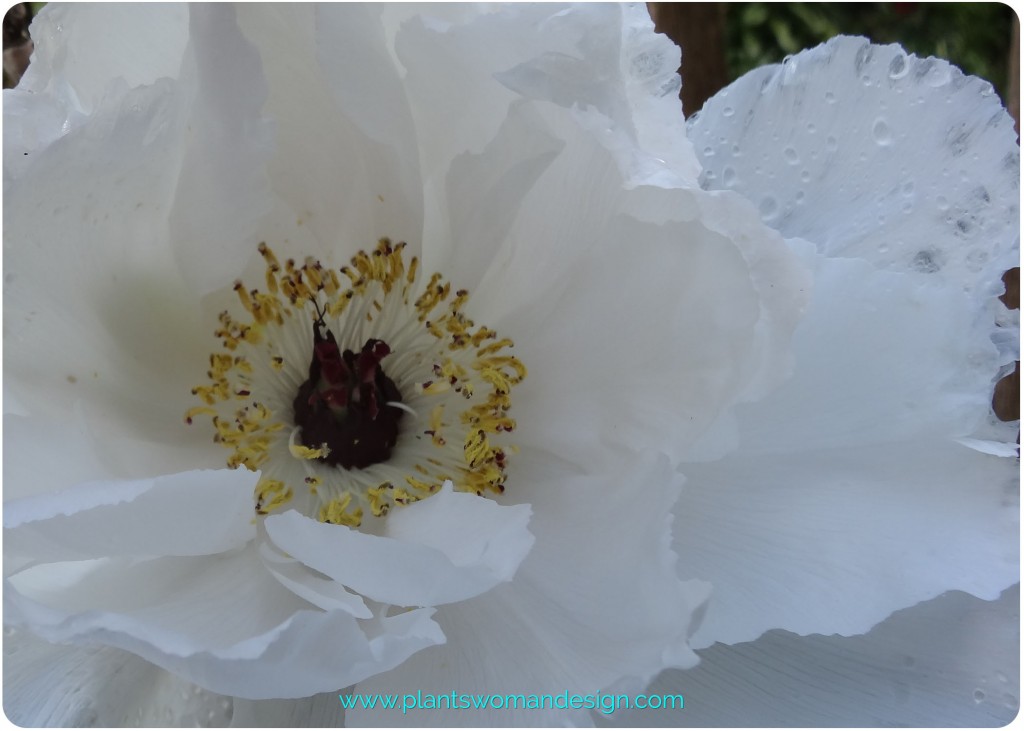
I have had this spider azalea (rhododendron ‘linearifolium’) for 10 years. It is one of the plants I take with me every time I move house. I think it will come with me again. Now it is happy with lily of the valley at its feet and Ranunculus aconitifolius ‘flore pleno’ in the background.
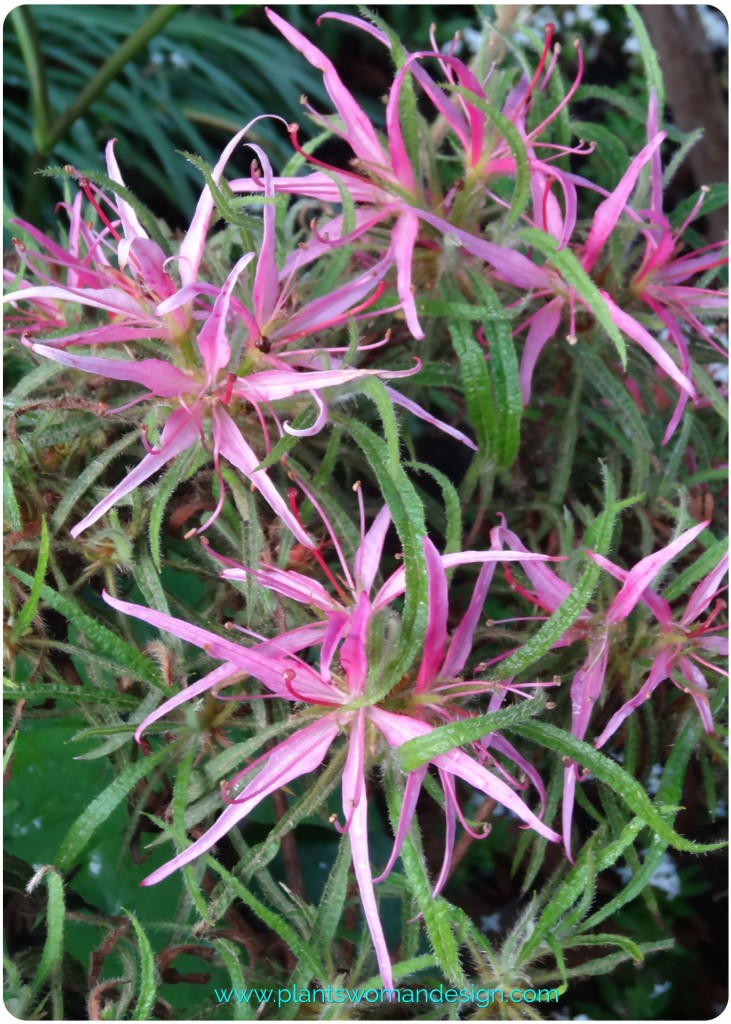
It is also rhododendron season here in the Pacific Northwest. They can look dull and uninteresting much of the year but right now they are the queens of the garden. Both of these large rhododendrons were from the previous owners. They are full and lush. I will share my secret for fabulous rhododendrons all year round in a future post.
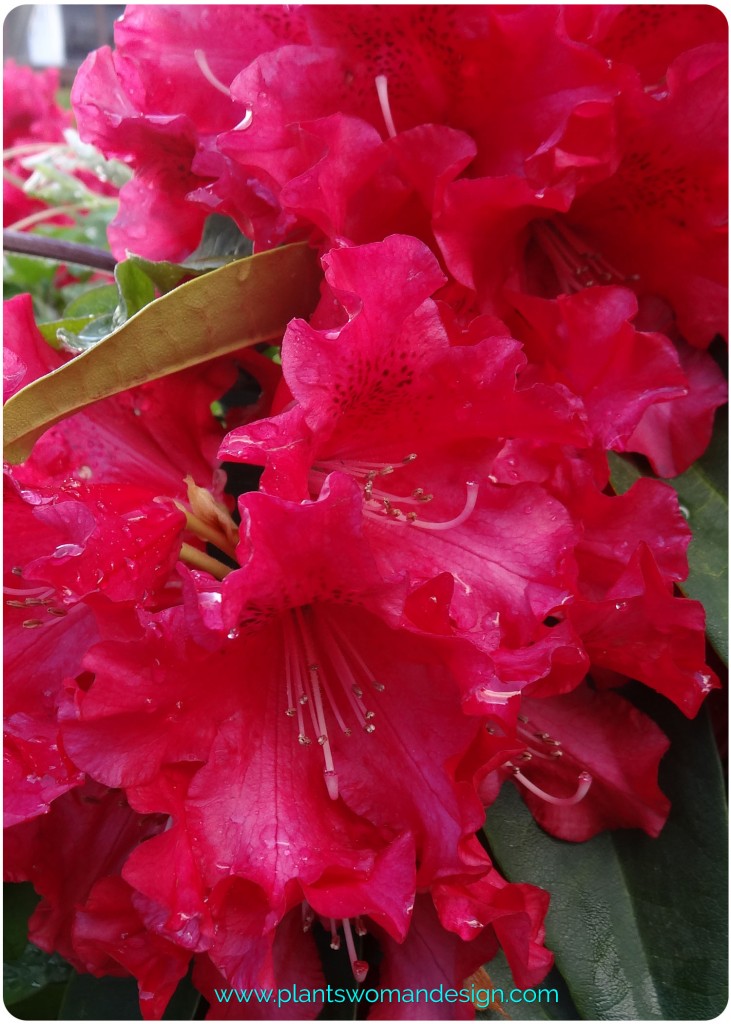
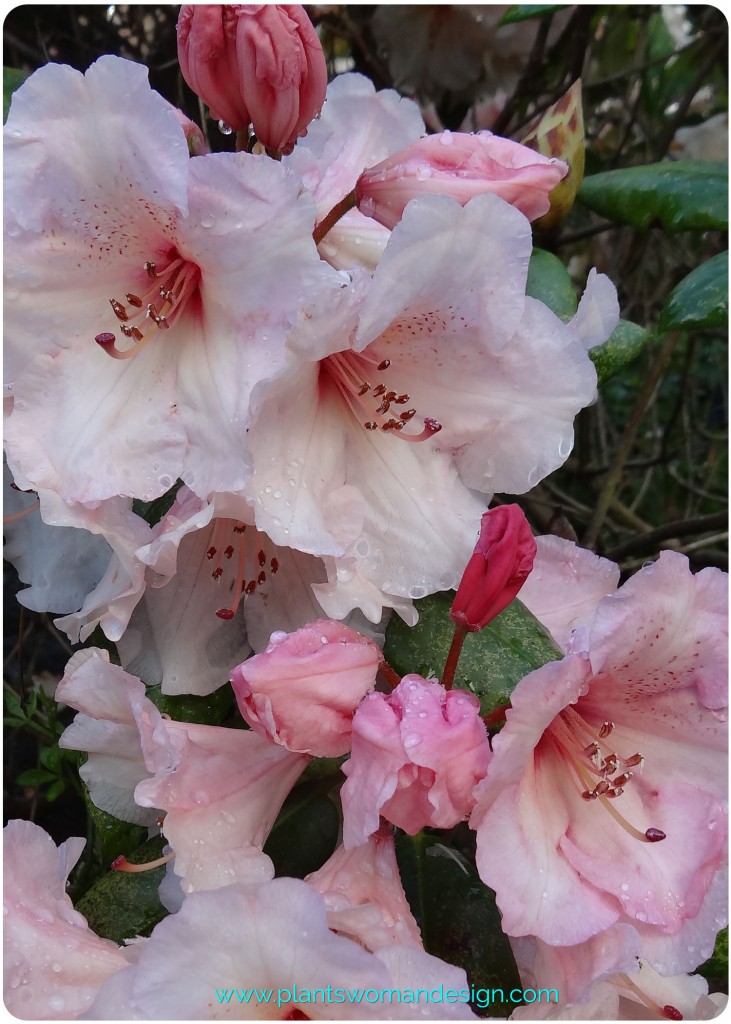
This sweet white rhododendron is rhododendron fragrantissima. Still in the pot it gets a special place by the door.
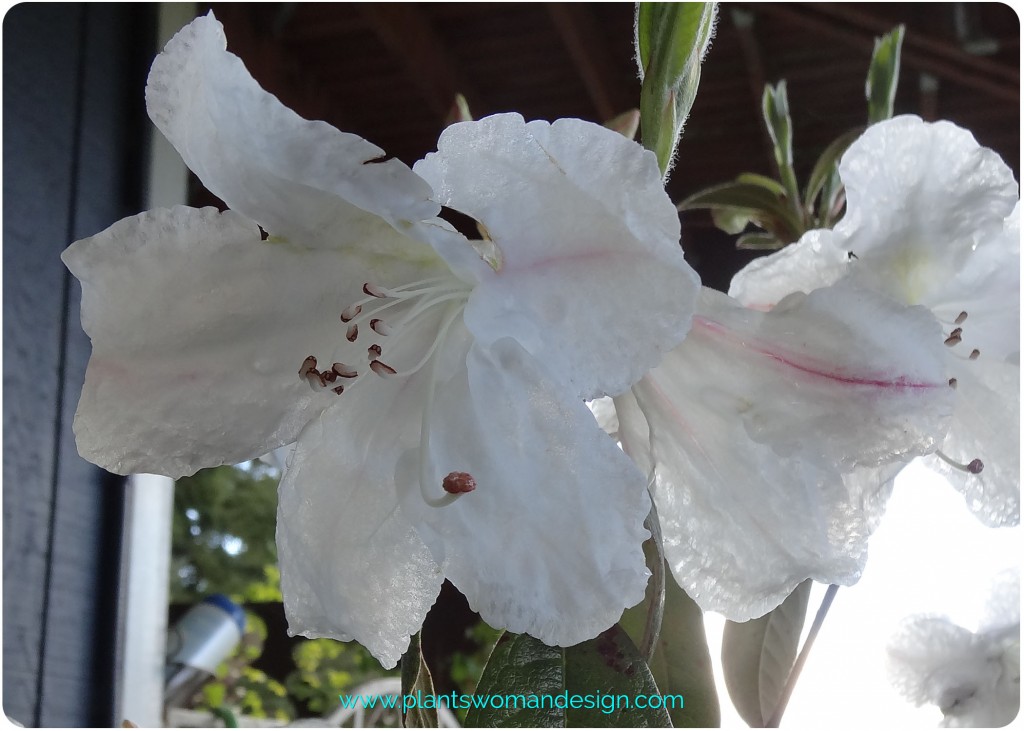
The excess moisture is what primroses thrive on. This candelabra primrose is happy in the mud and falling rain.
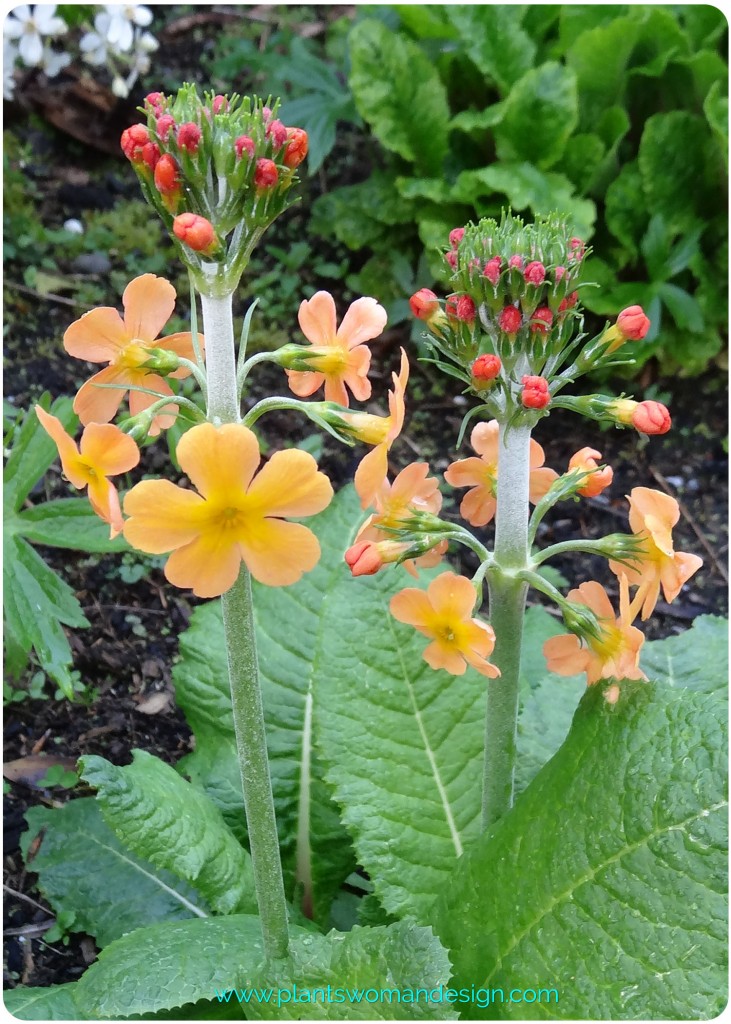
This blue aquilegia has just a touch of red in the bottom of the petals exactly the color of the barberry behind it. (It is actually Barberry ‘orange rocket’ but when the leaves are just coming out in the early spring they are very red).
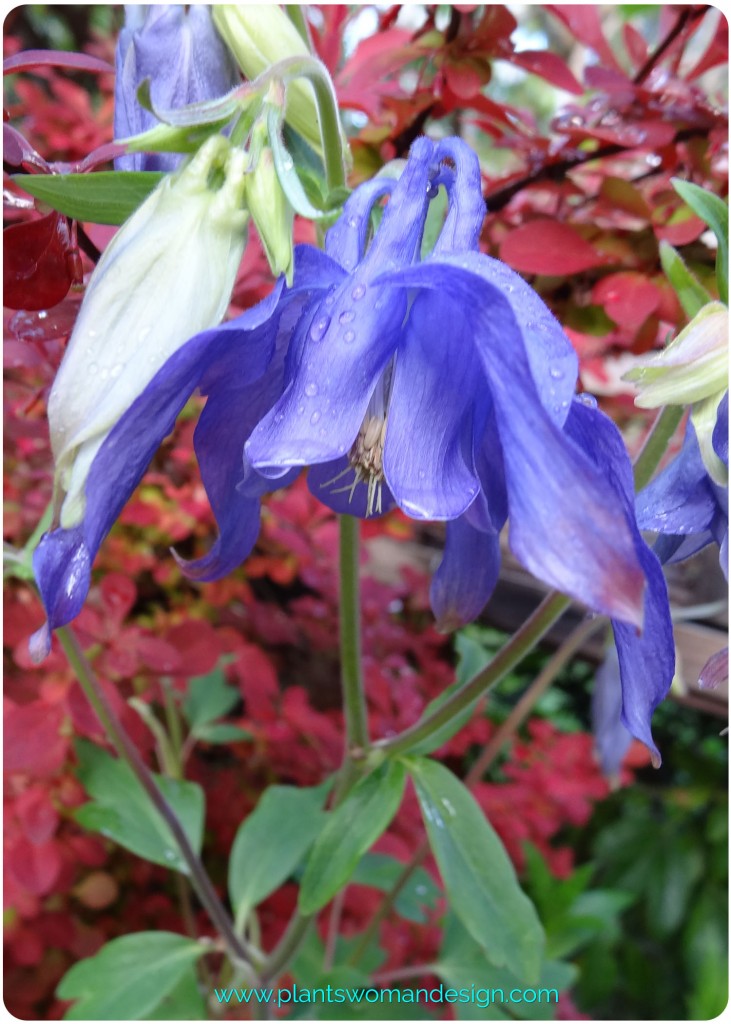
So, that’s what is happening in my garden right now. How are you faring with the rain and yuck? What are you seeing in your garden?
Send us a photo! You can email a photo and description to info{at}plantswomandesign{dot}com or upload it to our Face Book or Twitter pages. We’d love to see what’s going on in your yard and may have a little happy to send your way.
by Susan | Jan 29, 2014 | plants, Plantswoman Design
I have an obsession with plants. Just like a wino on a street corner with a brown paper wrapper around his obsession I wait at the mail box for mine. Dreaming of the fabulous plants, wondering if I could try something new, and finally clicking ‘ORDER”… I am always tempted by mail order catalogs that come in the mail and online and have ordered so many plants over the years just from descriptions in catalogs. Dan Hinkley’s Heronswood Catalog is fun to read just for the entertainment factor. I heard him speak this year about how hard it was to come up with those individualized descriptions.
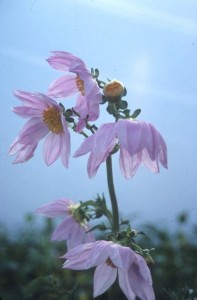
Grows to 108 inches tall Dahlia Imperialis
Now there are several I look at each year. Since I live on the Pacific Coast so many things can grow here. One of my favorite catalogs is the Plant Delights catalog. Even wrapped in brown paper from North Carolina they get here in great shape. I get a quarterly newsletter with an update plus the annual catalog. Tony Advent grows some amazing things there. I love to get the unusual things that are hardy in my area and also things like colocasia’s and gingers that are not. Every plant I have received from him, although small, has thrived. I’ve tried the huge Dahlia imperialis which is a Giant Tree Dahlia. The catalog promised that it would grow large in my area (it did) but would not bloom (it didn’t) because of lack of heat. The foliage was amazing and well worth the cost. He has 6 different liropes with only one available in my area nursery. This is just a small sampling of plant delights at Plant Delights Catalog.
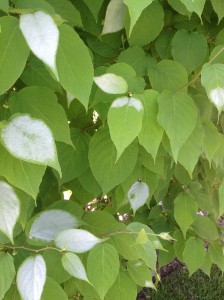
Silver Vine Actinidia Polygama
Forest Farm in Oregon has been selling mail order for many years. They are a small group of dedicated gardeners that grow usual and unusual plants. Many trees and shrubs along with perennials. The first time I got a small ‘tube’ with a tree inside I was petrified. I planted it and put stakes and twine around it so it wouldn’t get trampled. It did grow and was happy, putting on substantial height and branches in just a year. I’m not so afraid of these ‘tree tubes’ now and will often order for my customers things that I can’t find in the nursery’s here. For example, the Silver Vine (Actinidia Polygama) is a great vine that should be more readily available. Forest Farm had it so I ordered it for my client. I sometimes put smaller baby plants into a pot so I can grow them on a little before I place them for a client. They also have a great selection of unusual fruit trees.
Oregon is only about 3 hours from my home. Just across the border is another wonderful nursery Cistus Nursery on Sauvie Island next to the Columbia River. They sell both retail and mail order. I am addicted to browsing that nursery because there are some larger specimens there that can fit in the back of my truck. This is about the time each year I go down and visit. They also have a lot of plants available to send mail order. They specialize in Agaves, hardy tropicals, and drought tolerant plants. Many cactus varieties too. Manzanitas that are hardy and hardy Begonias too. I planted two of my favorite things (see blog post ‘These are a few of my favorite things) from here. The Camellia sinensis ‘blushing Maiden’, and the magnolia laevifoila (Michelia yunnanensis).
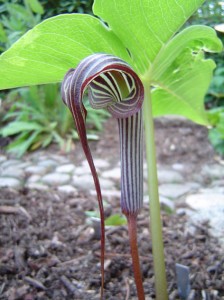
Arisaema franchetianum
A regular contributor to Fine Gardening Magazine Kelly Dodson also grows near by. His nursery Far Reaches Farm is an amazing place to visit. He is also an great gardener with practical knowledge about how to grow what he sells. He grows hardy (and non hardy) tropicals, including orchids. Amazing ferns, Arisaemas, and Mediterranean plants grow in greenhouses while hardy primroses, berberis varieties, and shrubs grow outside on the ground. Many of his offerings are available mail order. He has fans all over our area and beyond of the brown paper variety.
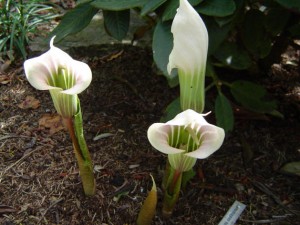
Arisaema candidissimum
Even closer to me is a new venture opening up soon. Dragonfly Farms Nursery has been open in Hansville for several years but this year they are doing something a little different. If you know the owner, Heidi Kaster, you are not surprised by that. She is starting up a mail order business in conjunction with her retail outlet. Heidi has always done a fabulous job growing seeds from all over the world. She will be getting back to that and selling what she grows. She is also teaming up with a couple of other savvy plant growers. Dave Dewire who owns Wabi Sabi Bonsai will be grafting and selling rare conifers. These plants will be grafted as pre-bonsai and sent on to plant people all over the world. He is amazing in his pruning and grafting abilities. Not to be left out of the loop is Dan Hinkley. I think he really can’t stand being ‘retired’. He will be also bringing plants to the nursery and selling them on line. We may be able to find some of the cool and unusual things he brings back from his most recent plant travels. The new website should be up and functioning by April You can check out Dragonfly Farms Nursery website for updated information.
When you unwrap your plants from the brown paper here are a few tips…
>>Check the ‘tube’ or pot that it came in. It should be damp or wet. If not then soak the plant until all the planting medium is wet through. I usually tease the roots apart without breaking them. I plant it at the same level as it was planted in the tube or pot. Not deeper or too shallow.
>>My garden has quite a lot of animal and people traffic where plants could get trampled easily so… If my new plant is small I will pot it up first before putting it into the garden. I have a transitional area that is shaded for the pots to grow on a little.
>>Order plants that will be ready to go into the garden when you get them. In other words, order tropicals later in the year not in January unless you have a greenhouse. Hardy (in your zone) plants can be transplanted all year into the garden but you may not see much growth for the first couple of months.
Good instructions are usually included with the shipment and every time I’ve had to call and ask a question I got great help.
When I look out in my own garden right now, I see some blank spots, I see plants that look bad after the winter, I see spaces where there were annuals, and bulbs. Now is a great time to see what has year round interest and what doesn’t. Conifers are showing up more and more in my garden. They have such great structure year round and add punctuation marks to the garden stopping your eye from skimming over a bed that is low and one height. The Northwest Flower and Garden Show also highlights some great local specialty nurseries. They bring plants and sell them retail at the show. Some are just starts in bags, some are in 1 gallon and 2 gallon containers. Hope to see you all there. I’m sure you will find me with some plants stashed behind my display garden or in my car.
Nursery’s listed in this post…
Plant Delights
Forest Farm
Cistus Nursery
Far Reaches Farm
Dragonfly Farms Nursery
by Susan | Jan 18, 2014 | gardening, plants, Plantswoman Design
Before the holiday hit I left you with a few things to do to put your garden to bed (click here to read part 1). Today I want to talk about putting your bulbs away for the season. I was waiting for some cold weather to hit so I could pull up the begonias, allium and dahlias to show how to put them away until next year. We finally got a very good hard freeze that lasted for almost 2 weeks. I pulled all the bulbs the first day of the freeze and set them in the greenhouse to dry (it is important to dry them out). Though they don’t look like much, the big clumps of soil and dried leaves indicate there are tuber and bulbs in there.

 When the soil you pulled up with your tubers and bulbs is dry and eagerly falls off it’s time to get back to them to prep them for storage. Break away the extra soil and brush them clean with a big, soft brush. They need to be as dirt free as possible and dry.
When the soil you pulled up with your tubers and bulbs is dry and eagerly falls off it’s time to get back to them to prep them for storage. Break away the extra soil and brush them clean with a big, soft brush. They need to be as dirt free as possible and dry.
These are cleaned up and ready to store.


I use white wood chips for storing. Since I use them for the hen house I have them already, shredded newspaper also works. The boxes are saved from tulip bulbs delivered from on line purchases. Pack them loosely and don’t crowd them. My boxes end up on the floor of the garage (cool dark place, no moisture). You could also store them in a dry, cool basement or refrigerator.
 Here is one begonia still in the pot living happily in soil and the lights of the green house. It has a great dark ruffled leaf.
Here is one begonia still in the pot living happily in soil and the lights of the green house. It has a great dark ruffled leaf.

Spring is coming slowly but surely, it won’t be long until it is time to put your bulbs all back in the ground again. You can put bulbs like hardy allium and left over Tulips or Daffodils into the ground again right now. There is still enough time to get a chill factor for the spring bulbs although they may come up a little later. Did you purchase spring spring flowering bulbs at sales (I do sometimes and then forget to put them in the ground). I usually try and make sure to have them stored in a cool place to this point. I have a refrigerator in my garage that has mostly drinks, for my crew, and plant material in it. Consider yourself warned, if you go looking for a soft drink or beer you might have to fight through bulbs or chilling seedlings.
During the holiday’s I like to force paperwhites. Once they are done blooming inside I move them, intact, to the greenhouse. When I put my tender tubers and bulbs in the ground I also pop my paperwhites in as well. They will “reset” themselves and bloom next spring. Most information you read about forcing bulbs says to discard after they are finished blooming. I have successfully replanted them in this fashion and had a 50% success rate with re-blooming the next year. Make sure not to cut back the foliage but plant out with foliage intact they need the green leaves to re-energize the bulb for reblooming.

My garden is now put to bed. I use these winter months to start thinking and planning for the coming year. When it is time to put the tuberous begonias, non-hardy allium, and dahlias back out I’ll give you a little tutorial on how to prep them for planting.
Until then happy planting!
by Susan | Jan 13, 2014 | gardening, plants, Plantswoman Design
It’s exciting to start a new year and 2014 already looks to be a busy and fun year. Gardeners in our area look forward to the winter solstice with more expectation than Christmas. As the shortest day of the year, seeing the sun set at 4:24 is downright depressing but there is a silver lining. Every day after the solstice brings a few minutes of daylight back to us and leads us into the hopeful season of spring.
This year has been a dry year with lots of sun so I should really not complain. Even today the sun was amazing, high about 40 with a ring of beautiful snowy mountains around the horizon. I put the Christmas decorations away and started raiding the greenhouse. My little greenhouse is tucked under a deck. It has sun on one side for about 7 hours a day, no direct overhead sun. Because of this, I have several bands of florescent lights to provide the needed additional light. I am able to over winter bananas, echevarias, tropical lilys, water plants, and other tropical treasures. I also keep good collection of orchids which I rotate into the house through out their blooming seasons. Although orchids would like to have warm days and cool nights they also do fairly well with consistent temps. I keep their water in a separate container at greenhouse temp so they don’t get cold water. Fertilizing with orchid fertilizer also helps to get some good blooms.

One orchid that was wonderful throughout the entire holiday season was this little gem, Zygopetalum, fragrant orchid. It sent up a spike in October and I moved it into the house in November. I kept smelling this wonderful fragrance and couldn’t figure out where it was coming from. Finally it occurred to me to smell the orchid. Orchids usually have no strong scent, however, this one is one of the most fragrant of all . The spike held 10 flowers and the scent filled the room. I moved it into my bedroom for the rest of the season.

This plant, bilbergia nutans Queens tears, I picked up at the Northwest Flower and Garden Show about 3 years ago. It loves being outside in the summer and takes almost no water. This year I divided it into about 20 babies and put the old one back in the pot. They like to be pot bound to bloom but this was beyond pot bound. Some of the babies were blooming and were given away to new homes. They don’t really take too much effort just don’t water and don’t let freeze.

This is a portion of my orchid bench in my green house. I have two vanilla orchids – vanilla planifolia. If you want to read something funny google “how to grow your own vanilla”. When I got to the “every day for six weeks, wrap the pods in a wet blanket to sweat and at night unwrap” part ,(after waiting 9-12 months for the bean to mature, pollinating flowers in the morning with a chopstick, after waiting 3-5 years for plant to mature) I vowed I would never attempt to grow my own vanilla even though (technically) I could. That gardener’s idea of easy is very different than mine.

Another orchid out of my greenhouse is Purple and brown and smell’s like pepper.

Veltheimia bracteata (Forest Lily) – I got this bulb for last years garden show. I just wanted it for my own greenhouse but don’t order that often from San Marcos in California. A client said he cares for one in the window of his house. These are just coming into spike and bloom .
What things do you, my gardening friends, do to bring the out doors in? What are you over wintering in your green house? Don’t have a green house? That’s okay, if you did have a green house what would be in it?
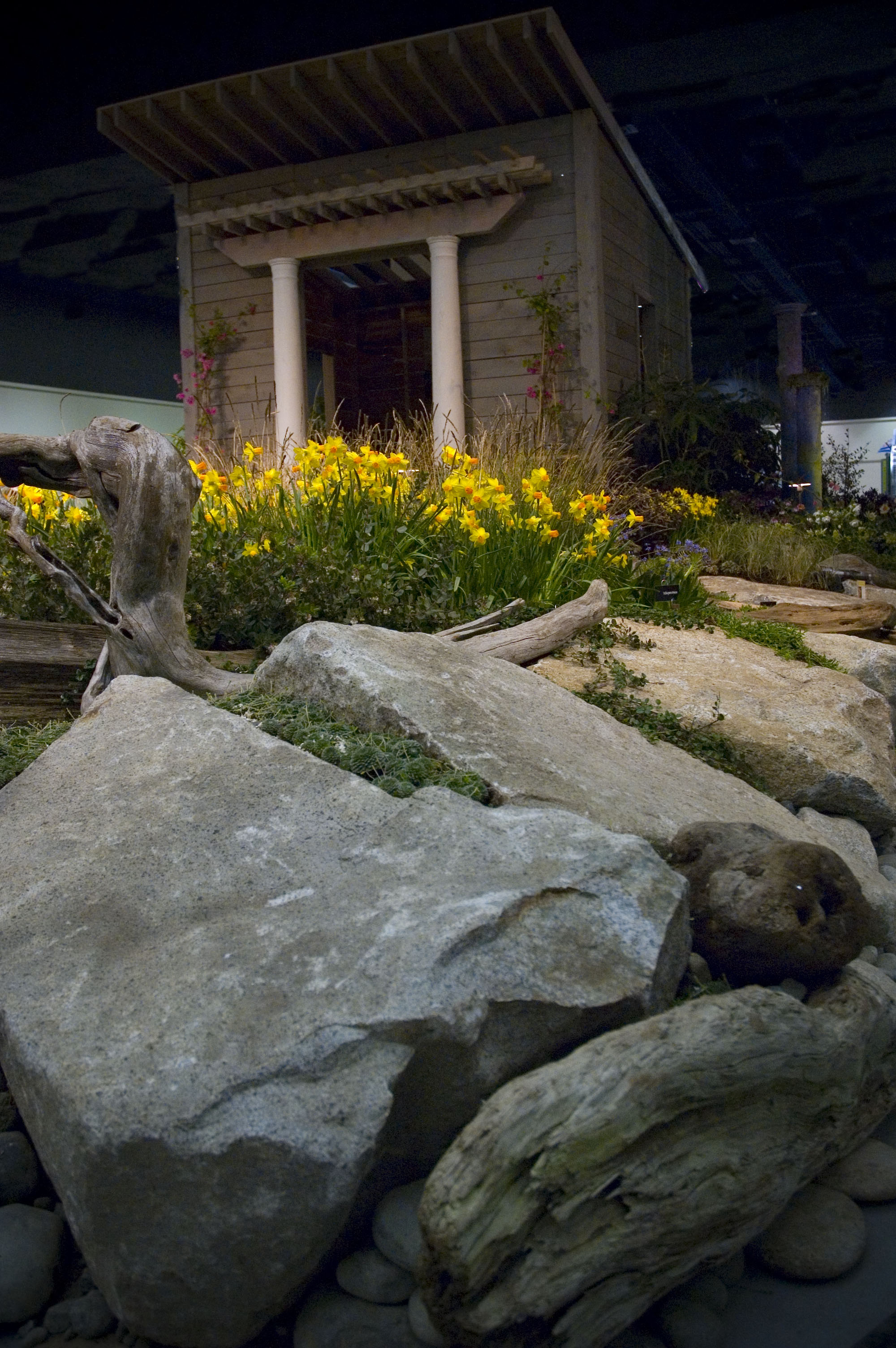
by plantswomandesign | Nov 23, 2013 | gardening, plants, Plantswoman Design
Smoke is rising from the chimneys, fog rolls down the bay, frost falls softly, quietly like snow on bare branches and dying leaves. Fall’s relentless march is fast fading into the dark misty morning and winter is close on it’s heels pushing its way in. The fabric of the garden changes dramatically overnight. Brilliance replaced by soft muted wheat colors, dusty purple, faded reds and oranges. Bare branches and stark silhouettes edge the once lush pathway. The time has come to tuck those tempermental, (temperiennials) into the garden for the winter.
As many of you know I love the huge foliage and exuberance of tropicalissimo. Every year I anticipate the window of time when I need to get them ready for the winter. Many of them can take the cold but can’t take the wet, many need mulch mounded around the base of their crowns to make it through a cold snap. There are many methods for doing this and I will share what I know and what has been successful in my garden.
I usually wait for the first quick frost to set the dormancy in motion. Sometimes we have great growing weather even in October and this year November. I have several plants that have already come into the greenhouse for overwintering that can take no frost. These have been in the greenhouse about 3 weeks now. A quick frost would kill the burgmansias, bouginvillas, and red bananas. The other things in my garden that are zone 8 can be successfully wintered over with help.
I have grown agaves in my garden for several years with only one making it through the winter. That winter I had a shrub growing nearby over hanging the plants. I had forgotten to cut it back during the summer and it was too late to do it by the time I noticed it. That next spring I found that where the shrub’s branches had covered the agaves they were alive and came through the winter fine. In the same bed where the branches didn’t reach the agaves they were dead. Ah Ha lesson learned. Now I use cut back pieces of my tall gingers to lay over the agaves. Their large leaves create air space and by waiting until they are nipped by frost they are not too heavy and full of moisture that they turn to mush on the ground.
 The Gunnera in the lower garden gets the same treatment. I use the leaves of the plant itself to give it protection. I cut them off and turn them upside down. The Gunnera signaled it’s dormancy early with curled dead edges on the leaves. This Gunnera is hardy here but by protecting the crown of the plant it takes less time to come back from dormancy and puts on fantastic growth each year.
The Gunnera in the lower garden gets the same treatment. I use the leaves of the plant itself to give it protection. I cut them off and turn them upside down. The Gunnera signaled it’s dormancy early with curled dead edges on the leaves. This Gunnera is hardy here but by protecting the crown of the plant it takes less time to come back from dormancy and puts on fantastic growth each year.
 Sometimes you can protect plants that are new to your garden for the first year in the same way. I put a Fremontodendron californicum (wooly flannel bush) in this year. I protected it with cut bamboo over the branches and crown. Because it has a branching structure already and is not completely herbaceous I didn’t want to lay anything too heavy to weigh down the branches. It hates water and is planted in gravel here. I’ll let you know if it survives. (If you want to read something interesting look up this plant on the internet. It has so much conflicting information published about it! One site says frost tender zone 8 and another say hardy to negative 20)
Sometimes you can protect plants that are new to your garden for the first year in the same way. I put a Fremontodendron californicum (wooly flannel bush) in this year. I protected it with cut bamboo over the branches and crown. Because it has a branching structure already and is not completely herbaceous I didn’t want to lay anything too heavy to weigh down the branches. It hates water and is planted in gravel here. I’ll let you know if it survives. (If you want to read something interesting look up this plant on the internet. It has so much conflicting information published about it! One site says frost tender zone 8 and another say hardy to negative 20)
 After the first frost I do cut down the gingers, cannas, and dahlias. I spread a thin layer of dry mulch over the top and also add fallen leaves over that. I use washed cow manure because it has nutrients to add to the soil as it decomposes. I leave these bulbs and temperiennals in the ground. They multiply and come back each year. My soil has lots of organic material in it and drains freely.
After the first frost I do cut down the gingers, cannas, and dahlias. I spread a thin layer of dry mulch over the top and also add fallen leaves over that. I use washed cow manure because it has nutrients to add to the soil as it decomposes. I leave these bulbs and temperiennals in the ground. They multiply and come back each year. My soil has lots of organic material in it and drains freely.
 Tuberose begonias get to come inside after the frost as well. They have been still growing and filling the spaces with fabulous oranges and reds until this frost. Prolonged freezing of these bulbs will result in death so don’t leave them outside. Again the frost helps the bulb know dormancy so the bulbs can be stored for winter.
Tuberose begonias get to come inside after the frost as well. They have been still growing and filling the spaces with fabulous oranges and reds until this frost. Prolonged freezing of these bulbs will result in death so don’t leave them outside. Again the frost helps the bulb know dormancy so the bulbs can be stored for winter.
It’s time to put the garden to bed. Stay tuned for our next post with more helpful information.
by plantswomandesign | Nov 14, 2013 | gardening, plants
Autumn is a time when everything starts to die back. The fun fluffy perennials, crazy growing annuals and lush trees change and start to go dormant. One of the best things about grasses is they begin to really put on a show. As they enter fall they look the best of their entire season of interest. The wonderful greens and infloresenses blend into a mixed bed but when the cool weather hits the other plants bow out and the grasses take center stage.
 Many people have a love/hate relationship with grasses. Some designers think they should only be used in full sweeps relegated to grass gardens and not integrated into garden beds. Others think they can be used in any situation and can translate into any style. I do like to use grasses in many situations but not in every situation. Most grasses are happy in full sun and bright areas with long vistas to view them at a distance. There are also lovely shade grasses available, usually showing up as bright spots in a dark area.
Many people have a love/hate relationship with grasses. Some designers think they should only be used in full sweeps relegated to grass gardens and not integrated into garden beds. Others think they can be used in any situation and can translate into any style. I do like to use grasses in many situations but not in every situation. Most grasses are happy in full sun and bright areas with long vistas to view them at a distance. There are also lovely shade grasses available, usually showing up as bright spots in a dark area.

hakonechloa macra aureola in a shady bed
The scale of a grass can sometimes overwhelm their surroundings become the dominate feature. Using them where they are happy and can maintain their upright sunniness will reward the gardener. Note how the Hakonechloa is balanced with shrubs that can maintain their own space in the garden with this, sometimes aggressive, grass nearby.
I love working with texture in the garden. Leaf color and shapes add so much more interest than just flowers. One area I really like to use grasses is in a beach garden. The color of the light near the water and scope of vision is fun to play with. I also like to play the soft light grasses against hardscape. The summer brings contrast between sun warmed rock surface and cool lush grasses while the same area becomes contrasted between the now cool gray surface and warm autumn tinted grasses in the fall.

pennisetum ‘red head’
 Some of my favorite grasses are:
Some of my favorite grasses are:
Panicum virginitum ‘Shenandoah’ Sheanandoah switch grass – Grows to 3-4 feet hardy from zone 5 – 9, Interest from July to February. lovely green soft colors and brilliant red tips and yellow in the fall. Panicles are red tangling with orange bits held above foliage. Winter color is wheat color with seed heads persisting through the season. Good in any soil, loves good strong light.

Panicum virginitum ‘Shenandoah’ Sheanandoah switch grass

leaf color on Panicum ‘Shenandoah’
Chionochloa Rubra – Red Tussock Grass – A drought tolerant evergreen grass with interest all year long. grows about 3 fee tall in my garden by about 4 feet spread. soft green in summer with color change to coppery wheat color in winter and back to green again. zone 7 – 9 grown in full sun with little water is when it looks the best!. Thin leaves and panicles dance in the slightest breeze.

Chionochloa Rubra – Red Tussock Grass
A dwarf miscanthus called ‘Little Kitten’ is also a favorite. I love Miscanthus but it is often too big for a normal garden bed and they don’t typically mix well with other plants when they are 6- 8 ft tall and very dominate. This gem is 3-4 feet in height. Has the typical miscanthus inflorescence on top. They stay upright and turn a fabulous fall color with all the colors of fall on the same plant Full sun, any soil, good drainage and not too wet are its best conditions. Zone 5-9.

‘Little Kitten’
I usually leave the grasses up until the late winter or even spring. If we have a snow I will cut them back after they are laying over. Birds use the seeds and small animals will overwinter in the dry area beneath the leaves. I will leave you with a border from one of my beach gardens. This has a lovely mixture of perennials, sedums, grasses, and small shrubs for a border that looks great all year long.

by plantswomandesign | Nov 6, 2013 | gardening, plants, Plantswoman Design
It is a beautiful day here on the west coast. It has been spectacular weather for fall color and feeling. Nippy in the morning with a tinge of wood smoke and fallen leaves in the air. Afternoons are sunny and you can see the sun on the horizon moving away to the south of the garden. Sunrises are coming up later and later with more awesome colors than I can describe.
These days I spend about 1 day a week prepping for the Northwest Flower and Garden show. I’m ordering plant material, picking it up and nestling it into the greenhouses that will hold our plant material until February. I have already ordered many flats of bulbs for the show that will be forced at their location and brought to the show blooming (hopefully). It is not an exact science so we do our best and have a plan B.
I always like to feature different types of plants in my show gardens. That is one of the reasons I first started coming to the flower and garden show all those years ago. I wanted to see something new and learn about what others were growing. Many times I saw something I had never seen before and I learned about it at the show. Now I guess I am a little jaded since entering the horticultural world. As a designer I get to see a lot of new plants and now say ‘I have one of those’ instead of ‘I want one of those’ and sometimes I have to say “Yep, I’ve killed one of those’.

- White Bouquet, Candy Club
iris reticulata natascha, fritillaria meleagris alba
As I prepare for the show I know I want some different types of bulbs. So on to the Van Engelen site I go and order some bulbs. I found these great (I hope) things called bunching tulips. They have multiple stems coming from the bulb with multiple flowers on them. I had never seen them before so I called my grower and asked about them. He said they had been around for several years and didn’t really sell well so they stopped growing them. Hmmm… Of course that means I have to try them. I ordered candy club and white bouquet.
Last year I forced Allium shubertii. It was difficult because they are a summer blooming bulb but I had about a 50% success rate. If the bulb blooms early in the year it is easier to force. If you plan on forcing bulbs you can count on at least a 12-14 week chill factor. That means you would place the bulbs into a dark 40-45 degree place in moist soil. Then add the actual blooming time and you will have a fairly good idea when to expect them. The folks at Van Engelen can help you with guesstimating if you are unsure. I received the order and put them into the shop refrigerator that has drinks and snacks for the crew. They had to put up with the boxes of bulbs for a couple of weeks… small price to pay, right?

Today I mixed up a fast draining soil mixture and added some bulb food. I placed the several bulbs in containers with the soil. I pack them together because I want the pot to be full and bursting with color. I don’t usually do that in the ground especially if they are naturalizing bulbs.
I also potted up some iris reticulata natascha, and some white blooming fritillaria meleagris alba.
I think maybe you can guess what color scheme I’m going for the show. I’m excited to do a more formal limited color palette this year.

I also could not resist adding some Christmas color into the forcing planting. I potted up some Amaryllis ‘nymph’ and amaryllis ‘white nymph’ for the Christmas season. I soak the bulbs overnight if the roots are dried out at all. Then I put them into the same bulb mixture as the tulips with fast draining soil and bulb food. I like planting the amaryllis in a soil mixture instead of plain water because I think water can stagnate sometimes and the bulb will rot. These are in my greenhouse now and not chilled. They will stay here until they start to bud. If it is close to Christmas they will go into the house. If they start too early I will move them to a cool frost free place to save the blooms until closer to Christmas.
I’m excited to see how these work into the Christmas scheme. Let me know if you have tried forcing bulbs before and how they turned out.
www.plantswomandesign.com | copyright 2013

 Next up is a free app called Tree ID and instead of using a recognition software it uses a database which is downloaded onto your phone/device. Once you open the app you answer some questions about your tree or plant and the app searches the database to find your answer. So I gave it a try. I diligently selected the leaf, leaf type, leaf arrangement, leaf size, leaflet size, number of leaflets (I didn’t really know what these were so I guessed to see what would happen), leaflet characteristics, leaf edge, leaf lobes (again, not quite sure), leaf edge teeth, leaf veins, leaf underside, leaf base, leaf stalk, leaf shape, leaf tip… And then you answer questions about the bark, autumn color, fruit and flowers. It took a long time to go through all that. I never knew there was so much that could be asked about leaves! And if that wasn’t enough I didn’t really know what half of the terms meant. There are little question mark symbols on each question that tell you what everything is but quite frankly I was a little overwhelmed by the detail. I tried to ID the lilac tree in our back yard by answering as many of the questions that I could and came up with no result. Then I tried again and reduced the number of questions I answered to give it a broader spectrum to choose from and still no result. By then I was just frustrated that technology had let me down that I went inside and did a little more research. There had to be something that was actually useful to a novice like me.
Next up is a free app called Tree ID and instead of using a recognition software it uses a database which is downloaded onto your phone/device. Once you open the app you answer some questions about your tree or plant and the app searches the database to find your answer. So I gave it a try. I diligently selected the leaf, leaf type, leaf arrangement, leaf size, leaflet size, number of leaflets (I didn’t really know what these were so I guessed to see what would happen), leaflet characteristics, leaf edge, leaf lobes (again, not quite sure), leaf edge teeth, leaf veins, leaf underside, leaf base, leaf stalk, leaf shape, leaf tip… And then you answer questions about the bark, autumn color, fruit and flowers. It took a long time to go through all that. I never knew there was so much that could be asked about leaves! And if that wasn’t enough I didn’t really know what half of the terms meant. There are little question mark symbols on each question that tell you what everything is but quite frankly I was a little overwhelmed by the detail. I tried to ID the lilac tree in our back yard by answering as many of the questions that I could and came up with no result. Then I tried again and reduced the number of questions I answered to give it a broader spectrum to choose from and still no result. By then I was just frustrated that technology had let me down that I went inside and did a little more research. There had to be something that was actually useful to a novice like me.
 Did you notice how many were in queue before me? 728! The confirmation emails also keep tally of how many submissions I have left. You get 20 submissions per month.
Did you notice how many were in queue before me? 728! The confirmation emails also keep tally of how many submissions I have left. You get 20 submissions per month. Click HERE to see all the answers they’ve sent me. I’ve sent in three submissions so far and all were correct with one slight exception. The identification of the tree with the leaf galls was given with a caveat that they couldn’t see enough of the tree to be sure so they made a guess.
Click HERE to see all the answers they’ve sent me. I’ve sent in three submissions so far and all were correct with one slight exception. The identification of the tree with the leaf galls was given with a caveat that they couldn’t see enough of the tree to be sure so they made a guess.























































